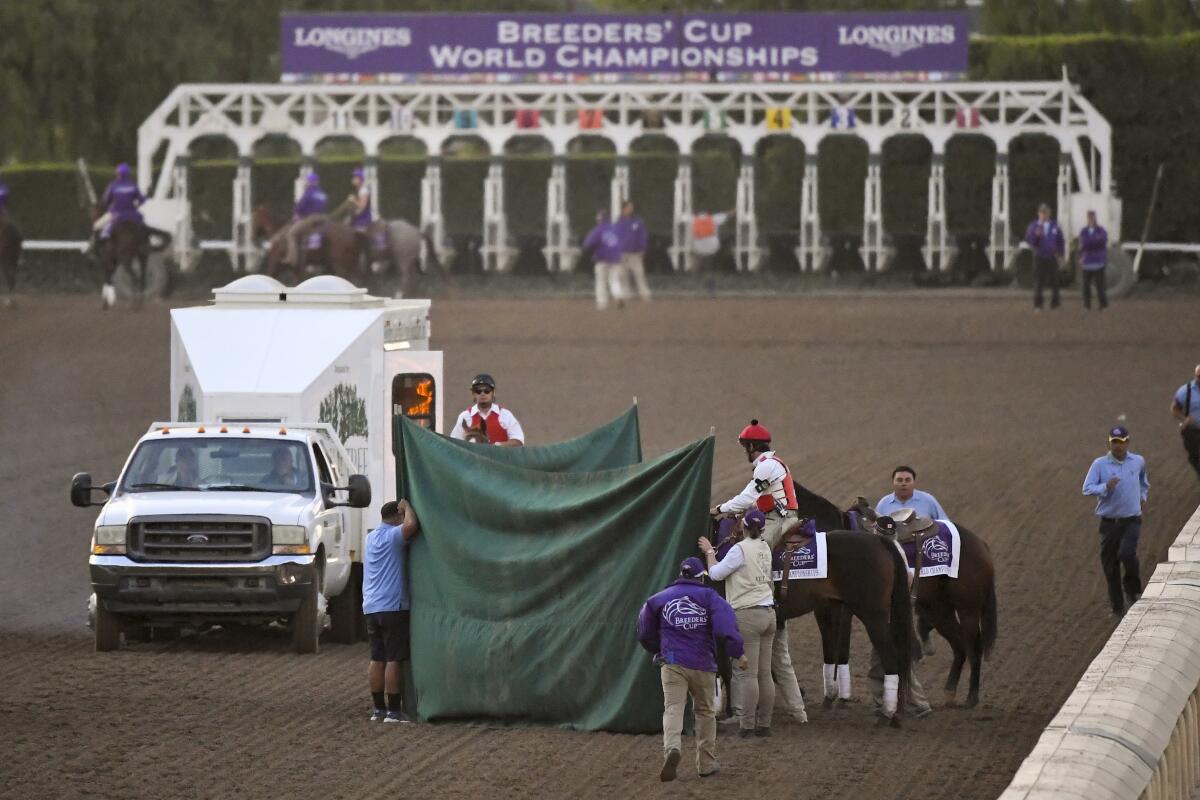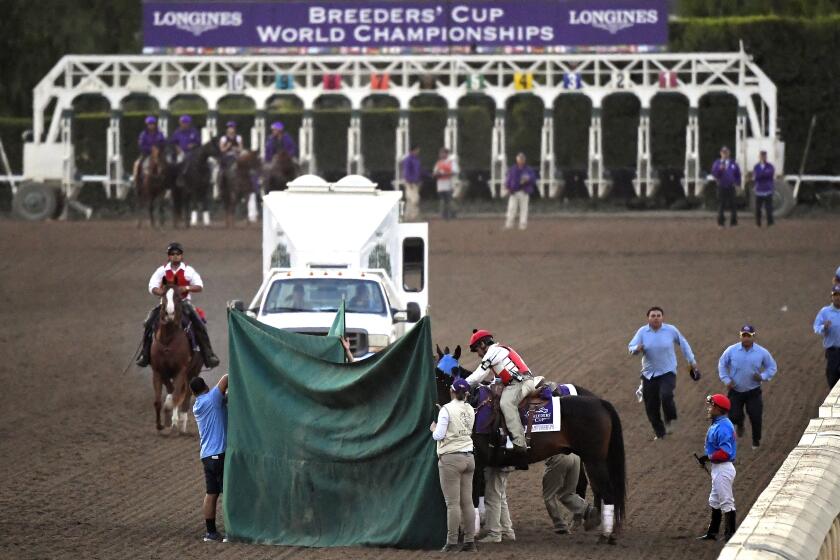A shaky start, but Breeders’ Cup aims to shake trend of high-profile horse deaths

- Share via
It’s been four years since horse racing found itself at the precipice of a perception problem about the safety of its athletes. Despite a nationwide reduction in fatalities, people keep asking the same question: why do race horses keep dying?
It has not been a good year for the sport, with a high-profile fatality spike at Churchill Downs in the time surrounding the Kentucky Derby. After the 12th death, racing was suspended at the iconic track and moved to Ellis Park. When the haze created by the Canadian wildfires lifted from Belmont Park and the third leg of the Triple Crown was run, there were six deaths, one of them on Belmont Stakes day.
New York racing moved upstate to Saratoga where 17 horses died, including two stakes horses on different weekends who broke down on the front stretch in grotesque fashion, sending patrons to the exits in tears.
The Horseracing Integrity and Safety Authority (HISA) was supposed to make all this better with a national approach to rules, regulation and safety. It did suggest to Churchill Downs that racing be moved, but an investigation had everything but a conclusion. The equine medical director of New York conducted an investigation into Saratoga, and early findings point to fatigue and inconsistency of the racing surface because of 11 inches of rain.
The size of a race horse and its natural instincts make it nearly impossible to survive serious injuries at the track, but many are trying to improve the odds.
The attention has shifted to Santa Anita this week, which was ground zero for fatalities in 2019 when 37 horses died racing or training. Friday and Saturday will be the 40th running of the Breeders’ Cup, a $31-million extravaganza that brings the best horses from around the world.
The lead-up has not been smooth. Despite almost 30 veterinarians, all the scanning equipment and all the protocols, there have been three incidents at Santa Anita leading up to the Breeders’ Cup, one of them fatal.
On Oct. 13, Echo Zulu, the Eclipse Award-winning filly, fractured her right front fetlock, similar to an ankle on a human, during training at Santa Anita and was given life-saving surgery. The procedure included a process called arthrodesis, which makes the area permanently immobile but eliminates any chance of rigorous riding. She is currently on schedule for recovery.
Then on Saturday, Geaux Rocket Ride, winner of the Haskell Stakes and one of the top horses in the Breeders’ Cup Classic, suffered a more serious injury after being inspected by many vets before his workout. Arthrodesis surgery was done but he didn’t respond as hoped and was euthanized Wednesday.
On Tuesday, Practical Move, winner of the Santa Anita Derby, dropped dead on the track after finishing a gallop. It was believed to be a heart issue.
Pierre and Leslie Amestoy’s Practical Move already qualified for the Kentucky Derby and go to post Saturday as the favorite in the Santa Anita Derby.
The answer to the question about horse deaths is one top industry officials still have trouble answering, falling back on processes they are trying to put in place.
“We know more progress needs to be done and that’s why we are working so hard,” said Drew Fleming, chief executive of the Breeders’ Cup. “We know when we invest in the ecosystem of care [it helps].
“The first [solution] is out-of-competition testing. It starts in July and goes all the way to Breeders’ Cup week. Second is the surface analysis and technology that we’ve implemented with [Santa Anita track superintendent] Dennis Moore, with [racing surface expert] Mick Peterson and with HISA. Third would be our veterinary screening and panel reviews. We talked about how extensive these are and we’re going to make more progress.”
Lisa Lazarus, chief executive of HISA, pointed to the gains that have been made.
The bond between man and animal is never so evident as between Cody’s Wish and Cody Dorman. Now the horse runs his final race in the Breeders’ Cup.
“One of the ways we explain it is we don’t know everything yet,” Lazarus said. “For the first time we have a national uniform body that can work with all stakeholders and can make sure we have the resources … to continue to do better. Certainly, we’ve made improvements and [Stronach Group equine medical director] Dr. [Dionne] Benson talked about the incredible progress we’ve made in California. We just have to continue on that path.”
In the 39 years, 14 horses have perished running in Breeders’ Cup races. The last one was in 2019 when Mongolian Groom broke down at the top of the homestretch at Santa Anita. An investigation by the Breeders’ Cup found that the death was preventable.
“The examining veterinarians made the right call on 252 horses,” the report said. “That is a 99.6% accuracy rate. The decision was wrong on only one horse: Mongolian Groom.”
California, following the lead of the Stronach Group, which owns Santa Anita, instituted many safety changes revolving around the screening of horses before workouts and races. A panel decides, based on past performances and other factors, if a horse is fit to run.
The California Horse Racing Board instituted a rule that every horse has to have a veterinary inspection within 72 hours of a workout. After trainer Dan Blacker was charged with 527 violations of this rule, a Times story pointed out it was a rule with no real-time enforcement because of lack of resources. The CHRB then asked that software be created to ensure rules are being followed.
All the changes in California have led to a 55% reduction in fatalities since 2019.
There’s an expression popularized by Mark Twain that there are three kinds of lies: lies, damned lies and statistics.
Lazarus said that HISA will have an equine database of fatalities next year. Currently, the accounting falls to the Equine Injury Database, run by the Jockey Club, a flawed system that counts only racing deaths and not those in training.
In addition, the voluntary EID does not require tracks to disclose fatality rates. The CHRB and New York Racing Assn. make their data available through public websites.
The current metric used by the EID is racing deaths per thousand starts. Last year the sport hit an all-time low of 1.25, down from 1.39 in 2021. In data compiled by The Times, using the EID metric, the Breeders’ Cup has a 39-year number of 3.11 deaths per thousand starts. There have been only 4,506 Breeders’ Cup starts. One of the deaths counted was an accident in the paddock.
In the last five years, the Breeders’ Cup number is 1.24, right at the national average, and 1.88 over the last 10 years. Santa Anita, as the Breeders’ Cup host, is at 2.25 and Churchill Downs, which hasn’t hosted since 2018, is at 2.84.
More to Read
Go beyond the scoreboard
Get the latest on L.A.'s teams in the daily Sports Report newsletter.
You may occasionally receive promotional content from the Los Angeles Times.















